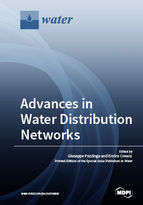Advances in Water Distribution Networks
A special issue of Water (ISSN 2073-4441). This special issue belongs to the section "Urban Water Management".
Deadline for manuscript submissions: closed (28 May 2018) | Viewed by 51824
Special Issue Editors
Interests: water distribution networks; unsteady flow; optimization; computational hydraulics
Interests: water distribution modelling; urban drainage modelling; real-time control; sediment transport in sewers; sustainable solutions for urban drainage systems; flood control in urban areas
Special Issues, Collections and Topics in MDPI journals
Special Issue Information
Dear Colleauges,
The research on water distribution networks has recently been characterized by a deep renewal and development, due to technical progress in control systems and computational resources. In the last few decades, the research has deepened the well established topics related to the quantitative simulation and optimization of water distribution systems, and it has broadened to water quality aspects, such as those concerning the network capacity in terms of residual disinfection and its protection from the effects of accidental or terroristic contamination events.
This Special Issue aims to point out the recent trends on water distribution modeling, regarding the opportunities introduced by technical progress for the simulation, design, and management of water distribution systems. Contributions are welcome on the following topics: simulation and optimization of water distribution systems, including pressure driven models, leakage detection and control, operation, pipe design, control valves, micro-turbines, pump scheduling, energy optimization, etc.; unsteady flow simulation, including unsteady friction, viscoelastic pipe behavior, transient cavitating flow, etc.; and water quality, including optimal placement of sensors for contaminant detection, reaction to contamination, network recovery after contamination, etc.
Prof. Dr. Giuseppe Pezzinga
Dr. Enrico Creaco
Guest Editors
Manuscript Submission Information
Manuscripts should be submitted online at www.mdpi.com by registering and logging in to this website. Once you are registered, click here to go to the submission form. Manuscripts can be submitted until the deadline. All submissions that pass pre-check are peer-reviewed. Accepted papers will be published continuously in the journal (as soon as accepted) and will be listed together on the special issue website. Research articles, review articles as well as short communications are invited. For planned papers, a title and short abstract (about 100 words) can be sent to the Editorial Office for announcement on this website.
Submitted manuscripts should not have been published previously, nor be under consideration for publication elsewhere (except conference proceedings papers). All manuscripts are thoroughly refereed through a single-blind peer-review process. A guide for authors and other relevant information for submission of manuscripts is available on the Instructions for Authors page. Water is an international peer-reviewed open access semimonthly journal published by MDPI.
Please visit the Instructions for Authors page before submitting a manuscript. The Article Processing Charge (APC) for publication in this open access journal is 2600 CHF (Swiss Francs). Submitted papers should be well formatted and use good English. Authors may use MDPI's English editing service prior to publication or during author revisions.
Keywords
- optimization
- design
- leakage
- pressure control
- energy
- unsteady flow
- friction
- viscoelasticity
- cavitation
- water quality
- protection from contamination







